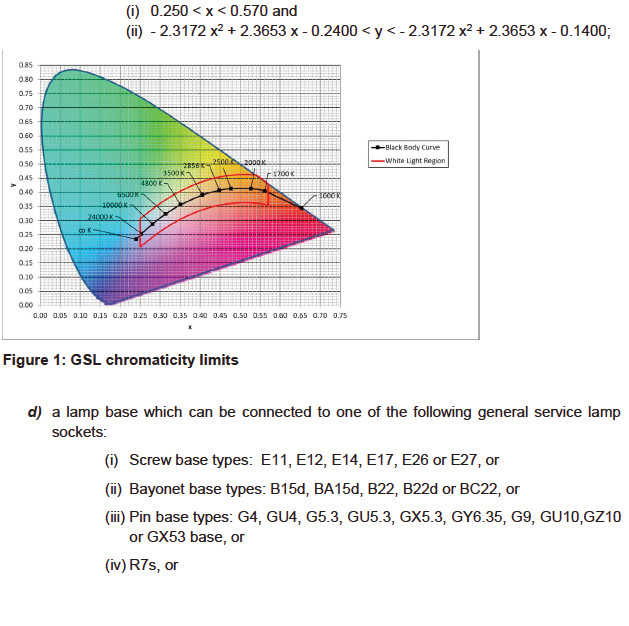This compulsory specification covers the energy efficiency and functional performance for general lighting directional and non-directional lamps of all shapes and finishes; using incandescent, halogen, fluorescent, light emitting diode (LED), and other light source technologies (not including high-intensity discharge lamps); that also satisfies a) to d):
| (a) |
Capable of operating on a voltage up to 300V of either direct current or alternating current with a frequency of 50Hz; |
| (b) |
Emitting light with a total luminous flux of 60 to 3300 lumens; |
| (c) |
Light emission with the chromaticity coordinates (x, y) that are within the range (shown in Figure 1): |

(v) Alternative base types which can be connected to the above lamp base sockets by using commercially available passive adaptors.
The following lamps are excluded from the energy efficiency and functional performance requirements of this compulsory specification:
| (a) |
the primary purpose of the light is not general illumination and the product packaging is prominently marked as such, e.g. but not limited to: |
| (aa) |
emission of light as an agent in chemical or biological processes (other than human visual perception), e.g. but not limited to: |
| (ii) |
ultraviolet light used for curing/drying/hardening, |
| (iii) |
photodynamic therapy, |
| (vi) |
medical applications, |
| (ix) |
anti-insect products; |
| (b) |
image capture and image projection, e.g. but not limited to: |
| (c) |
signalling, e.g. but not limited to: |
| (iii) |
road-signalling and traffic control, and |
| (iv) |
air traffic-signalling and airfield lamps; |
| (d) |
the spectral distribution of the light is adjusted to the specific needs of particular technical equipment, in addition to making the scene or object visible for humans, e.g. but not limited to: |
| (ii) |
performance special effects lighting, and |
| (e) |
the scene or object lit requires special protection from the negative effects of the light source, e.g. but not limited to: |
| (i) |
lighting with dedicated filtering for photosensitive patients, and |
| (ii) |
lighting with dedicated filtering for photosensitive museum exhibits; |
| (f) |
lighting is required only for emergency situations, e.g. but not limited to emergency lighting luminaires; |
| (g) |
requiring ambient temperatures above 120°C and this exemption only applies to incandescent and halogen lamps with the following characteristics: |
| (i) |
an overall length of maximum 60 mm, |
| (ii) |
a rated power of maximum 25 W, |
| (iii) |
a base type of E14 or B15, and |
| (iv) |
a rated luminous flux of maximum 225 lm. |
| (h) |
reference lamps used for national measurement standards; |
| (i) |
light sources for battery operated products, including but not limited to mobile phones, torches, camping lights, toys, armbands, solar powered garden lamps, bicycle lights and other non-motorized vehicle lights, etc.; and |
| (j) |
halogen light sources with R7s cap and luminous flux ≤ 2,700 lumens or > 12,000 lumens. |
 Financial Acts Package
Financial Acts Package
